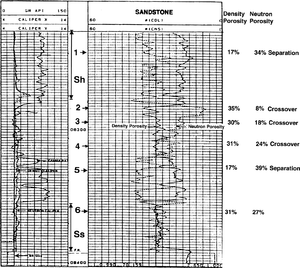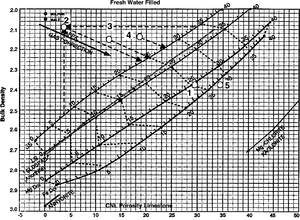Density-neutron log porosity
| Exploring for Oil and Gas Traps | |

| |
| Series | Treatise in Petroleum Geology |
|---|---|
| Part | Predicting the occurrence of oil and gas traps |
| Chapter | Predicting reservoir system quality and performance |
| Author | Dan J. Hartmann, Edward A. Beaumont |
| Link | Web page |
| Store | AAPG Store |
The combination of the density and neutron logs provides a good source of porosity data, especially in formations of complex lithology. Better estimates of porosity are possible with the combination than using either tool or sonic separately because inferences about lithology and fluid content can be made.
Density log
The density log measures the electron density of a formation. The logging device is a contact tool that emits gamma rays from a source. Emitted gamma rays collide with formation electrons and scatter. A detector, located a fixed distance from the tool source, counts the number of returning gamma rays. The number of returning gamma rays is an indicator of formation bulk density. The litho-density tool (LDT) also provides a photoelectron (Pe) cross section curve, an independent indicator of lithology.
Obtaining porosities from a density log
Formation bulk density is a function of matrix density, porosity, and fluids contained in the pore space. Formation bulk density measured by the log must be corrected for borehole irregularities. Convert bulk density to porosity using charts in a log interpretation chartbook, or calculate porosity from bulk density using this equation:
where:
- Φ = porosity
- ρma = matrix density (see table below)
- ρb = formation bulk density (log value)
- ρf = density of the fluid saturating the rock immediately surrounding the borehole—usually mud filtrate (use 1.0 for freshwater and 1.1 for saltwater mud)
Use the lithology matrix densities to determine porosity and average Pe to determine lithology listed in the table below.
| Lithology | Density, g/cc | Average pe |
|---|---|---|
| Sandstone | 2.65 | 1.8 |
| Limestone | 2.71 | 4.8 |
| Dolomite | 2.876 | 3.0 |
| Anhydrite | 2.977 | 5.05 |
| Salt | 2.032 | 4.6 |
Neutron log
The neutron log mainly measures hydrogen concentration in a formation. The logging device is a noncontact tool that emits neutrons from a source. Emitted neutrons collide with nuclei of the formation and lose some of their energy. Maximum energy loss occurs when emitted neutrons collide with hydrogen atoms because a neutron and a hydrogen atom have almost the same mass. Therefore, most neutron energy loss occurs in the part of the formation that has the highest hydrogen concentration.
Neutron energy loss can be related to porosity because in porous formations, hydrogen is concentrated in the fluid filling the pores. Reservoirs whose pores are gas filled may have a lower porosity than the same pores filled with oil or water because gas has a lower concentration of hydrogen atoms than either oil or water.
Obtaining porosities from a neutron log
Lithology, porosity, fluid type, and tool type affect neutron log response. When interpreting neutron logs, use the specific log for the specific tool, i.e., the charts in logging chart books that are specific to the sidewall neutron log (SNP) or the compensated neutron log (CNL).
To obtain porosity, read the value directly from the log. If the log is recorded in limestone units and the formation you wish to evaluate is sandstone or dolomite, then correct the log value by using the appropriate chart in a log interpretation chartbook.
Combination density–neutron logs
The density–neutron log is a combination log that simultaneously records neutron and density porosity. In some zones, porosities recorded on the logs differ for three reasons:
- The matrix density used by the logging program to calculate porosity is different from the actual formation matrix density.
- Gas is present in the formation pore space.
- Shale/clay is present in the formation.
Obtaining porosity from density–neutron logs
It is always best to read porosities directly from the logs where the lithologic units match the formation lithology. To obtain correct porosities from density–neutron logs when the two logs record different porosities for a zone, use one of the methods listed below.
| Condition | Method |
|---|---|
| Log matrix lithology is known and the two log curves separate (density porosity is less than neutron porosity) | If density porosity is less than neutron porosity, such as in a sandstone with shale/clay content, the density log provides a reasonable approximation of formation porosity. |
| Log matrix lithology is known and there is crossover (density porosity is greater than neutron porosity) | Crossover (density porosity is greater than neutron porosity) is due to the presence of gas in the formation. Recompute density porosity using
Use gas density instead of water density. |
| Chartbook is available | Plot the porosities on a density–neutron crossplot from a log interpretation chartbook. Use the appropriate crossplot for the log type (i.e., SNP, CNL) and mud type (fresh or salt). |
| Chartbook is not available | Calculate porosity using the equation
where Φ is percent porosity, ΦN is neutron percent porosity, and ΦD is density percent porosity. |
Example density-neutron log

The example log in Figure 1 was recorded in sandstone units. Where the density and neutron logs nearly track together, the formation lithology normally is assumed to be sandstone (in the figure below). The slight separations may be due to changes in lithology as in more shale/clay. Where the density and neutron logs separate, either the lithology is different (neutron porosity > density porosity) from the recorded lithologic units (points 1 and 5) or gas is present (points 2, 3, and 4). A density–neutron crossplot resolves the separation problem (see Figure 2).
Using a density–neutron crossplot
To determine lithology or correct porosities for lithologic or gas effects from a density–neutron crossplot, follow the steps listed below.
- 1. Use the table below to determine how to enter a neutron porosity value.
| If… | Then… |
|---|---|
| Neutron porosity is in limestone units | Enter the chart along the x-axis with neutron porosity. Project up to density porosity. |
| Neutron porosity is in sandstone or dolomite units | Enter the chart on the sandstone or dolomite line. Project up or down to a density value. |
- 2. Use the table below to determine how to enter a density porosity value
| If… | Then… |
|---|---|
| Density log porosity is in sandstone, limestone or dolomite units | Find the density log percent porosity value on the diagonal line that matches the lithologic units recorded on the log (i.e., use the sandstone line if the log was recorded in sandstone units). Move left or right to intercept the neutron projection. |
| Density log scale is bulk density | Enter the y-axis with the log bulk density value and intercept the neutron projection. |
- 3. Use the table below to determine formation lithology and porosity.
| If… | Then… |
|---|---|
| Point falls on a diagonal line | The point defines the lithology of the formation by which line it falls on and the porosity is the value marked on the line at that point. |
| Point falls away from appropriate diagonal line | Move down and to the right parallel to the nearest dashed line until a diagonal line is intersected. Read the value for porosity at that point. The lithology is a combination of the lithologies of the lines on either side of the point of intersection. Gas is present if the original point is northwest of the appropriate diagonal lithology line. |
Example density–neutron crossplot

Figure 2 is an example density-neutron crossplot. Points 1–5 are from the log (Figure 1). Points 2, 3, and 4 are from a zone that shows crossover. Crossover occurs when the density log reads higher than the neutron log in a zone of the same lithology as the log matrix lithology, i.e., sandstone. Point 2 has the greatest crossover; Point 4, the least. Once completed, the well from which this log was taken showed Point 2 to be in a gas reservoir, Point 3 to be in light oil reservoir, and Point 4 to be in a zone with residual oil.
Porosities corrected for gas effect are 24%, 25%, and 28%. Points 1 and 5 are in shale zones, even though they plot as dolomite. They are shale reference points for this interval of the log.
Stratigraphic knowledge critical to interpretation
The density-neutron crossplot helps determine lithology of oil- or water-filled formations that are pure lithologies like sandstone, limestone, or dolomite. The density–neutron crossplot analysis can be ambiguous when the formation is of mixed mineralogies, like a dolomite-cemented sandstone.
When gas is present, the situation is much more complicated. Knowing the mineralogical compositions of formations to be drilled is critical when interpreting a density–neutron crossplot and predicting the presence of gas.
As an example, the presence of clay in a sandstone drives a crossplot point toward the shale reference point. Adding gas to the same sandstone makes it look like a clean sandstone. As another example, add gas to a dolomite and it looks like a limestone, not a dolomite with gas. In both cases, if we know the stratigraphic details, we can interpret the presence of gas from the crossplot.
See also
- Determining water saturation
- Archie equation
- Determining Rt
- Calculating Rw from SP logs
- Pickett plot construction
References
- ↑ 1.0 1.1 Alberty, M. W., 1994, Standard interpretation; part 4—wireline methods, in D. Morton-Thompson and A. M. Woods, eds., Development Geology Reference Manual: AAPG Methods in Exploration Series 10, p. 180–185.

